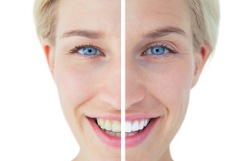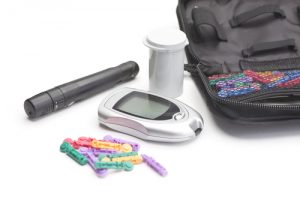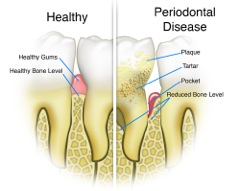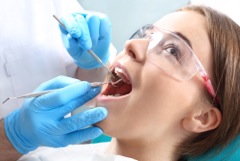Are you destroying your pearly whites without realizing it? You might be doing permanent damage if you’re a nail biter or using your teeth to rip off the price tag from that new dress.
Stop and heed this advice: Brush your teeth twice daily, floss daily, regularly visit your dentist and have a good, balanced diet. All of those things are going to protect you from damaging your teeth and enamel.
The American Dental Association has developed a list of surprising ways you’re damaging your teeth and Dr. Meyers has culled the top 5:
1. Overdoing sugary food and drinks – even cough drops
Forget cookies, cupcakes and candy. Those are obvious cavity-promoting foods. Astonishingly enough, even things like throat lozenges can be bad. But we also want to think about where we might be getting other sources of sugar, like sports drinks and not enough water.
The good news is you can help stave off cavities by using toothpaste recommended by your dentist and keeping the sugary snacks to a minimum.
2. Lack of water
Skip the energy drinks, flavored sports waters and ice teas if you want to dodge cavities. Instead, drink H2O. Not only is it good to hydrate your body, but it’s good to hydrate your mouth.
A dry mouth can be an environment where it’s easier for bacteria to cause cavities. Fluoride is found in tap water and some bottled water, and can ward off tooth decay. That’s why it’s important to drink as much as possible.
3. Nail biting
Get those fingers out of your mouth! When we bite our nails, we put our jaws in a protrusive position, meaning the lower jaw projects out and moves in a repetitive, unnatural way. It can cause pain and discomfort in the jaw, plus wear down the enamel on your pearly whites.
4. Heavy brushing
Go easy on your chompers, because brushing aggressively can abrade your teeth. Not only can it strip the teeth of their enamel, promoting cavities and decay, but it can also cause the gums to recede.
5. Consuming acidic food or drinks
People who have acid reflux or drink lemon water can expect to see damage to their teeth, says the ADA. Acidic foods can strip the teeth of their natural enamel. Citric fruits and fruit juices, sparkling water with lemon and even certain salad dressings are so acidic that they can cause the tooth’s enamel to erode.
6. Using your teeth as tools
You had that one friend in college who could pop open a beer with his mouth. Have you seen him since? Using your teeth as tools to open bottles, rip off tags or for any purpose besides chewing food can cause serious fractures. These can worsen over time and become infected.
7. Thumb sucking
It sounds innocent, but thumb sucking is considered a trauma, dentists say. The habit pushes on the upper palate, forcing permanent teeth to move or spread apart. And it’s a hard one to break.
Dentists can talk to parents about proper dental care and ways to break the habit, such as using praise when a child doesn’t suck his or her thumb rather than criticism when they do, or encouraging the child to limit their thumb sucking to bedtime rather than all day.
8. Smoking
This is a given. Smoking has proven health consequences – like increasing the risk for oral cancer and respiratory conditions – and that extends to teeth. Huffing on cigarettes also increases plaque and bacteria, which can lead to gum disease.
9. Chewing ice
You take a sip of your soda, catch a couple ice cubes in your mouth and what do you do? Chew them, right? Bad move. Don’t do this often – or ever – if you want to prevent a painful injury. Ice is very hard and can cause breakage of teeth and fillings.
 No one wants to have yellow teeth but the methods that we often use to whiten them can be invasive to some patients. The most common ingredient in dental office bleaching sessions is hydrogen peroxide and the most common ingredient in at-home whitening treatment kits is carbamide peroxide. Some who undergo whitening treatments with these chemicals have reported increased sensitivity, so we are suggesting some alternative ways to keep your pearly whites white. Here are six suggestions that may surprise you:
No one wants to have yellow teeth but the methods that we often use to whiten them can be invasive to some patients. The most common ingredient in dental office bleaching sessions is hydrogen peroxide and the most common ingredient in at-home whitening treatment kits is carbamide peroxide. Some who undergo whitening treatments with these chemicals have reported increased sensitivity, so we are suggesting some alternative ways to keep your pearly whites white. Here are six suggestions that may surprise you: News out of Melbourne, Australia this month that a team of scientists at the University of Melbourne’s Oral Health CRC has been working on a vaccine treatment for chronic periodontitis could herald a breakthrough in the gum disease, with clinical trials beginning in 2018.
News out of Melbourne, Australia this month that a team of scientists at the University of Melbourne’s Oral Health CRC has been working on a vaccine treatment for chronic periodontitis could herald a breakthrough in the gum disease, with clinical trials beginning in 2018. We tell our children not to eat too much sugar, because sugary snacks and drinks can cause cavities. This information is true, of course, but we should be reminding ourselves as adults that the relationship between overdoing our sugar intake and our oral health is even more complex than we might admit. It turns out that the relationship between periodontitis (“inflammation around the tooth,” a serious gum infection that damages the soft tissue and bone that supports the tooth) and diabetes is a strong one indeed.
We tell our children not to eat too much sugar, because sugary snacks and drinks can cause cavities. This information is true, of course, but we should be reminding ourselves as adults that the relationship between overdoing our sugar intake and our oral health is even more complex than we might admit. It turns out that the relationship between periodontitis (“inflammation around the tooth,” a serious gum infection that damages the soft tissue and bone that supports the tooth) and diabetes is a strong one indeed. Gum recession is a common dental problem that causes concern among many people, but because of its gradual occurrence, most people don’t realize they have recession until the first signs appear. Two telltale signs of gum recession include tooth sensitivity or noticing a tooth that looks longer than normal. (Typically, a notch or “pocket” can be felt near the gum line.)
Gum recession is a common dental problem that causes concern among many people, but because of its gradual occurrence, most people don’t realize they have recession until the first signs appear. Two telltale signs of gum recession include tooth sensitivity or noticing a tooth that looks longer than normal. (Typically, a notch or “pocket” can be felt near the gum line.) Thanks to technological advances, dental patients today have several choices when it comes to selecting materials to fill cavities. They can choose between amalgam and composite fillings, which are often referred to as “silver” and “white,” respectively, or tooth-colored porcelain fillings.
Thanks to technological advances, dental patients today have several choices when it comes to selecting materials to fill cavities. They can choose between amalgam and composite fillings, which are often referred to as “silver” and “white,” respectively, or tooth-colored porcelain fillings.

